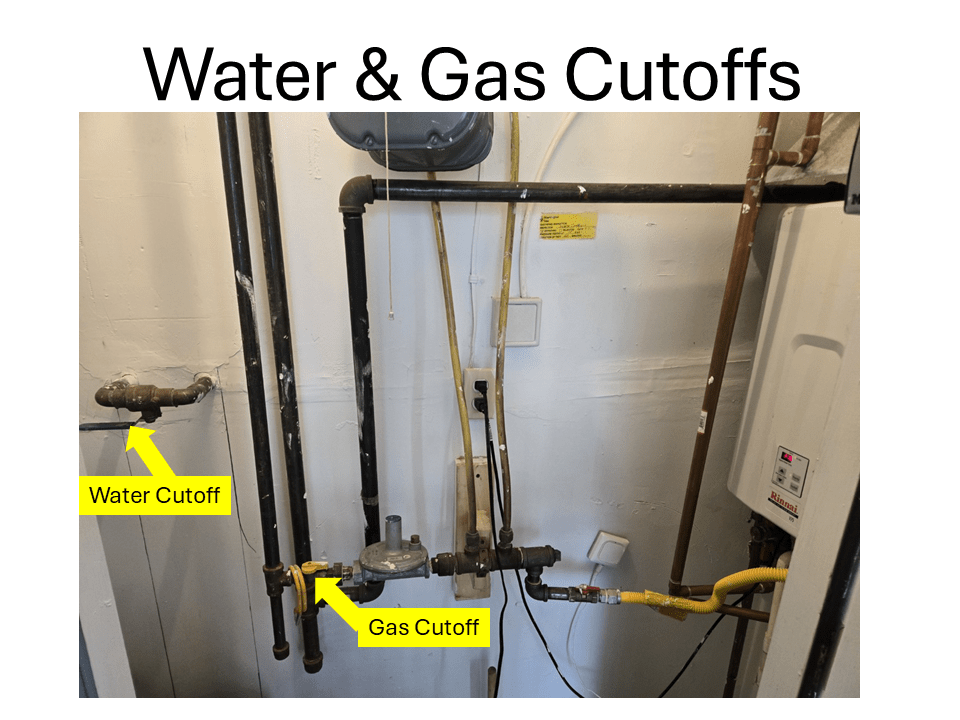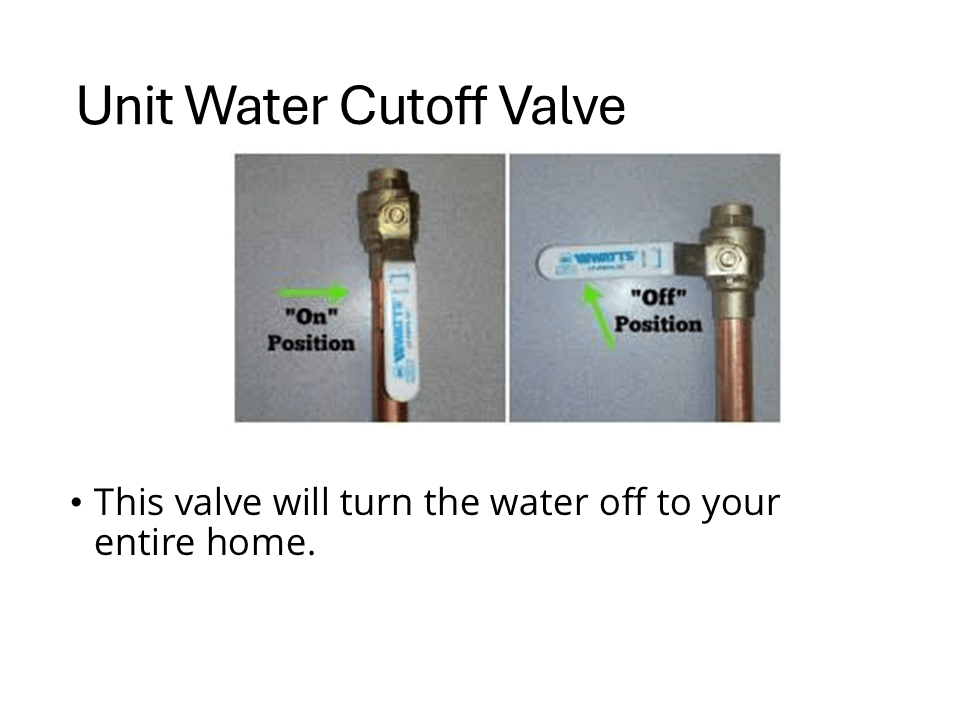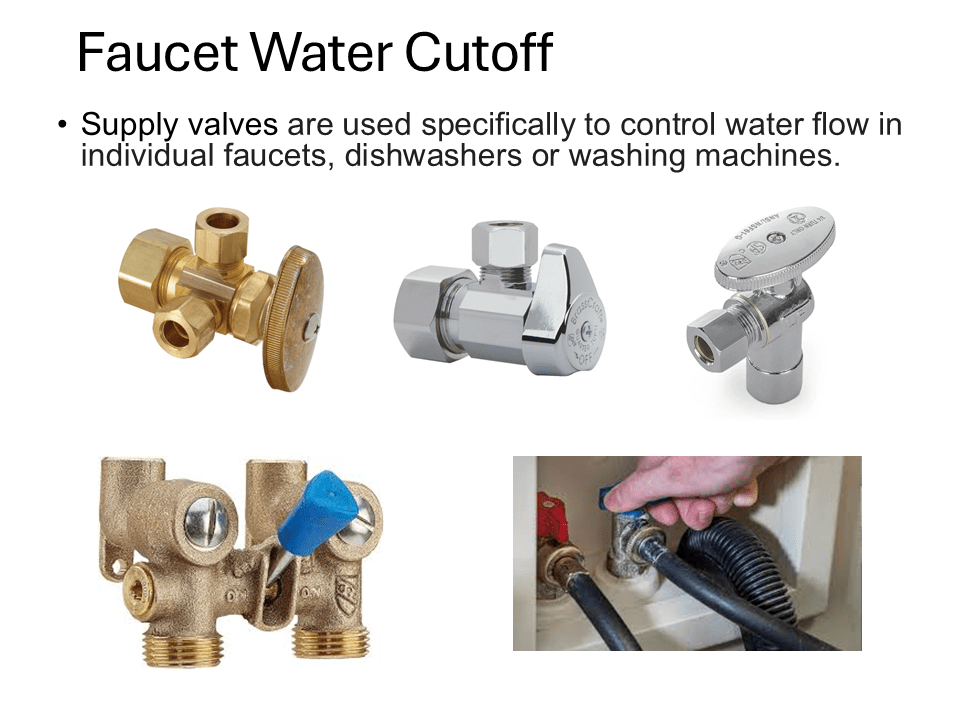Water Leaks
What to do if you Suspect a Leak
During Business Hours
- Use the table below to gather info about the leak. More information will help management determine the proper response.
- Call management at 252.2003.
After Hours
- Use the table below to gather info about the leak.
- If the leak is not active (there is no significant water or moisture present) call management during business hours.
- If the leak is active (water is dripping or flowing) Call management at 252.2003.
If the leak persists after the unit water is turned off or affects multiple units, residents must notify management promptly. This will enable us to make sure that any areas impacted by the leak are properly addressed.
If you repair the leak independently without approval, you’ll be responsible for the costs.
What Happens When a Leak Occurs?
- Management will coordinate an inspection to assess the scope and impact of the leak.
- Management will coordinate with contractors to stop the source of the leak and mitigate the water damage.
- The extent of the response depends on the situation. The contractors and/or management will advise you of the steps that need to be taken.
How Is the Damage from the Leak Repaired?
Management will coordinate with contractors to get estimates for required repairs. You will be given the option to use your selected contractors if you wish. If you choose to use your own contractors, sign a release, and produce receipts from a properly licensed contractor, the Association will agree to reimburse you up to the amount of the receipts but not to exceed the estimate from our contractor.
Who Pays for the Mitigation and Repairs?
If damages originate from a specific unit, the owner of that unit is responsible for repairs to the source of the damage and the cost of repairs up to the master insurance deductible, not exceeding $10,000 per unit, in accordance with the Maryland Condominium Act.
Per the Bylaws and Maryland Condominium Act, where the Association assumes responsibilities for repairs, the Association is only responsible for restoring the unit to original construction.
Restoring the unit to original construction means restoring it to the finishes such as flooring, counters and cabinets that were in place when the unit was built. Upgrades to the unit are known as betterments.
Unit owners are responsible for the costs of any betterments.
The homeowner and any tenant(s) should ensure that their Homeowners and Renters Insurance policies provide coverage for betterments, improvements, contents, alternative living arrangements, and utility costs.
Types of Leaks
There are several types of water leaks that occur in individual units. The type of leak you observe can give you a hint on the cause and how to stop it.
| Type of Leak | Cause | The Fix |
|---|---|---|
| Drips from skylights | Caulk around the skylight is worn or damaged. | Have a contractor go on the roof to check the seal around the skylight. |
| Drips around or below a window. | Water can enter thru gaps in the windows in your unit or the windows in units above yours. | Have a contractor check the inside and outside seal around the window. |
| Drips from the ceiling around an Air Vent, Light, Sprinkler Head, Drywall Seam or you have discoloration in a section of the ceiling. | Water can enter thru gaps in the siding, roofs, skylights or vents. Pinhole leaks or failures where pipes connect can cause leaks. | Shut off the shutoff valves for your unit. Open a faucet to drain the water out of the pipes. If the water leak stops, you know the leak is in your unit. If not check the units above you. Have a contractor use a moisture meter and/or cut open the area to find the source of the leak. |
| Accumulation of water or damp carpet on the floor but does not appear to be dripping from the ceiling. | Water that enters the wall and goes to the floor from pinhole leaks or failures. | Shut off the shutoff valves for your unit. Open a faucet to drain the water out of the pipes. If the water leak stops, you know the leak is in your unit. If not check the units above you. Have a contractor use a moisture meter and/or cut open the area to find the source of the leak. |
| Accumulation of water or damp carpet on the floor around the sliding glass door to the balcony to patio but does not appear to be dripping from the ceiling and only occurs during of right after a rainstorm. | Water can get to the floor through gaps under the sliding glass door. | Have a contractor check the interior & exterior seals around the sliding door. |
| Clean water accumulates on the bathroom floor or drips from a bathroom ceiling. | A pipe or fixture may have failed in your unit or one above you. The seal around the tub or shower or toilet is failing. The toilet may have overflowed in your unit or the unit above you. | Visually inspect the pipes under faucets. Check around the toilet. Shut off the shutoff valve for your unit. Open a faucet to drain the water out of the pipes. If the water stops, you know the leak is in your unit. If not check the units above you. Have a contractor use a moisture meter and/or cut open the area to find the source of the leak. |
| Dirty water accumulates on a bathroom floor or drips from a bathroom ceiling. | Drain or toilet in your unit or one above you may be leaking. The toilet may have overflowed in your unit or the unit above you. | Visually inspect the pipes under faucets. Check around the toilet. Check the units above you. Have a contractor use a moisture meter and/or cut open the area to find the source of the leak. |
| Water accumulates on a kitchen floor or drips from a kitchen ceiling. | A pipe, fixture or dishwasher may have failed in your unit or one above you. The pipe or hose to the ice maker or water dispenser in the refrigerator may have failed in your unit or one above you. | Check around the dishwasher and refrigerator in your units and the units above you. Shut off the shutoff valves for your unit. Open a faucet to drain the water out of the pipes If the water stops, you know the leak is in your unit. If not check the units above you. |
| Water accumulates on the floor around the washing machine. | A pipe, fixture or washing machine, may have failed. | Check around the washing machine. If the leak only occurs when the washing machine is in- use have the machine checked. Shut off the shutoff valves for your unit. If the water stops, you know the leak is in your unit. If not check the units above you. |
| Water accumulates on the floor or drips from the ceiling in the water heater closet. | Water heater may be leaking in your unit or a unit above. A pipe or connection may be leaking. | Check around the water heater. Have a contractor use a moisture meter and/or cut open the area to find the source of the leak. Shut off the shutoff valves for your unit. Open a faucet to drain the water out of the pipes If the water stops, you know the leak is in your unit. If not check the units above you. |
| Water accumulates on the floor or drips from the ceiling in the corner of the living room or bedroom on the other side of the water heater closet. | A pipe or connection may be leaking in your unit or a unit above. The seal around the sliding glass door in your unit or a unit above may be leaking | Cut off the shutoff valves in each unit. Open a faucet to drain the water out of the pipes. If the water stops flowing a pipe feeding that unit has a leak. Have a contractor use a moisture meter and/or cut open the area to find the source of the leak. |
Leaks from Condensate Lines
Air conditioner units located in the unit drain water to the outside of the buildings. If the lines clog it can cause water to leak to the floor where the unit is located and to the unit below.
Air conditioner units are located in the wall in the front entry way. In some units there in an access panel in the bathroom behind the air conditioner unit to give you access to the unit. In others, access can be gained from the hall closet next to the front door.
Sprinklers
Because the fire department must be notified of any shutdown of the sprinklers, the sprinklers can only be cut off by a certified contractor selected by the condominium association. Call management at 240.252.2003
Location of Water Pipes
The feed from the unit side of the unit shutoff valve connects directly to a manifold that connects to individual flexible pipes that run to each cold-water fixture. Another feed goes to the water heater, The water heater connects to a manifold that connects to individual flexible pipes that run to each hot water fixture.
The cold & hot water manifolds are located in the ceiling in the corner of the living room on the other side of the water heater closet.
Pipes for the top floors run thru the ceiling of the unit below. The cold & hot water manifolds for the top floor units are located in the unit below.
Location of Unit Water Shutoffs
The water main for all units and the unit shutoff valve is located in the water heater closet on the balcony or patio. It is advisable to locate, mark, or otherwise identify the shutoff valve for your unit before a leak occurs.



